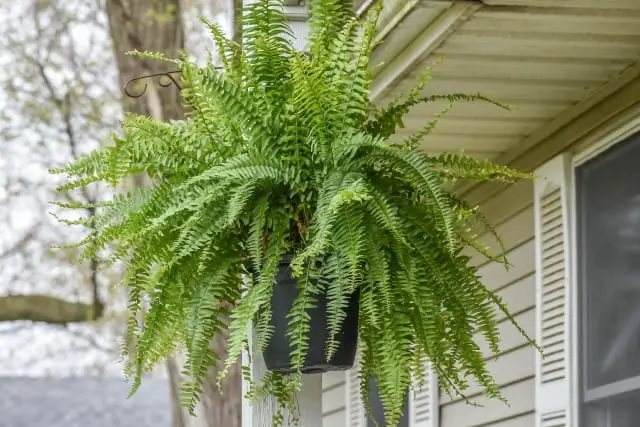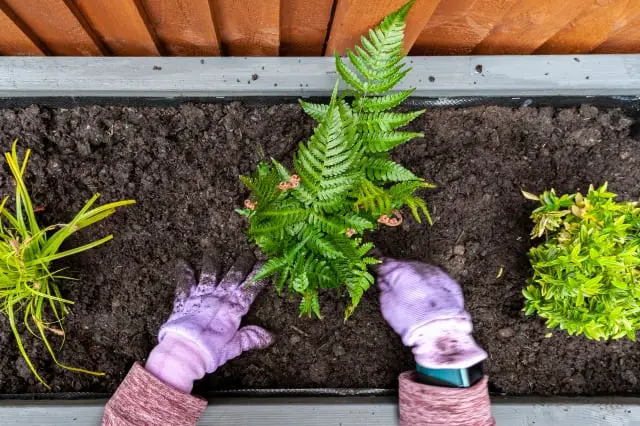Sometimes the weather can catch us out. A sudden cold snap or unseasonal frost can damage even hardy ferns, and it’s not always clear whether they can be saved.
Ferns can recover from a freeze as long as the roots and rhizome have not been killed. Potted ferns should be moved into a porch, garage or utility room that is sheltered but not heated like the main house, and the extent of root damage assessed. For outdoor ferns, the roots are less likely to freeze, but damage to the fronds can be severe. With careful watering, pruning and cold protection many ferns can be saved and recover from the shock.
The key principle for recovering a frozen fern is to take things cautiously. A light frost rarely causes lasting damage, but a more prolonged or more severe cold spell can cause the water in the plant’s cells to freeze. That can cause serious damage, especially if the fern is thawed too quickly.

The way to save a frozen fern is to ensure the roots and rhizome are able to recover. A cold snap stresses the plant, and you want to minimize any further stresses. So, don’t be too quick with warming the plant up, pruning away the dead fronds, or trying to stimulate growth. Take it steady, and give the roots the best chance of recuperating before taking serious action.
The specific steps to take will differ depending on the cold hardiness of the fern, and whether it is planted in a pot, container or the ground. Let’s take them one by one.
How to recover frozen ferns in pots
Ferns left outside in small pots or hanging baskets will be most vulnerable to cold damage, but you can also intervene easily and quickly to cope with an unexpected freeze. If you have been caught out by a cold snap, here’s what to do.
First, move the fern inside, but only into a sheltered space like a porch, shed or garage, not into the main house. This will protect the plant against further frost damage, without stressing it with a sudden move to a warm environment. If your specimen is a tropical variety (like the Boston fern, or Staghorn fern) then you can ultimately move it into the house, but only once it has recovered from the worst of the cold damage.

Boston fern
- Nephrolepis exaltata
- Evergreen
- Partial shade
- Height: up to 1 m
- Soil: acid or neutral. Moist, well-drained.
Next, water the pot well. This has two benefits. First it will gently thaw any frozen soil, and it will also rehydrate the plant, giving it the essential resources for recovery. It might seem counter-intuitive, but a freeze will actually dehydrate the fern (as water will no longer be flowing freely), and so it is important to keep the roots well watered.
At this point, patience is a virtue. You may be tempted to try some pampering, like feeding or pruning, but this would only add additional stress to an already struggling plant. It is best to wait several days, even weeks, to observe the extent of the damage. You can wrap the pot in insulating plastic or burlap at this point if air temperatures are low, to make sure the roots are well protected.
If the fronds have been irreversibly damaged they may naturally drop off. Alternatively, you may have localized damage, with some fronds dying but others surviving. Once you are confident that the fern has stabilized and adapted to its new home, then you can cut back the dead foliage, starting with the fronds around the base of the plant, and working upwards. Cut back to near the crown.
Finally, you can check the state of the roots directly for cold damage. Carefully slide the root ball from the pot and examine the state of the roots. The ones nearest the edge of the pot are most likely to have been frost-damaged. Dead roots will be black and soft. These should be cut away to prevent fungal or bacterial infection. Once you have cleaned back to living roots, repot the fern in new potting mix, but do not add fertilizer. Water well, of course.
This care regime will give the fern its best chance for recovery. If the fern has retained some healthy fronds, then your chances are very good that it will fully recover. Ultimately, though, you will not know for sure whether you have succeeded until new fiddlesticks emerge in the next growing season.
How to recover frozen ferns in containers
The next situation to consider is when the fern is it a pot that is too large to move, or in a fixed container in the garden. The roots of these plants will be more protected from a freeze than smaller pots or baskets, but they are still vulnerable.

If these ferns suffer a hard frost, the best plan is to protect them as well as you can. First, give the container a thorough water to defrost the soil and provide the hydration needed for the roots to recover and survive. Then, mulch the surface of the container well.
The best mulches are bark chippings, leaf mold or straw. These coarse mulches will trap plenty of air, and protect the surface of the soil against further frosts. This is essential for protecting the superficial roots and rhizome of the fern, which must be preserved if the fern is to survive.
Next, depending on the depth and width of the container, you could insulate the side of the planter with a wrap – burlap, old blankets, or bubble wrap. An alternative to this (admittedly rather unsightly) strategy would be to use a winterproof container in the first place. There are many products available made from layered or heat-trapping materials that protect the internal soil against cold. In fact, it is possible to grow ferns outside their normal hardiness zones if such planters are combined with a good surface mulch.
Protecting outdoor ferns against a freeze
For ferns planted directly into the ground, there is less that you can do to recover an already frozen plant, simply because excavating it is going to cause more harm than good. That said, it is also far less likely that a sudden frost would cause lasting damage to the roots of an established fern in the garden – especially if it is a native variety that is adapted to the local climate.
The biggest risk for an outdoor fern is when water pools in the crown at the base of the fronds and freezes. This forms ice right at the most delicate part of the plant, against the growing region of the rhizome. Kill that, and you kill the fern.
If this is a risk, pack the crown with dry mulch material – ideal would be dead leaves (not yet rotted into mold), or straw. These are absorbent but also insulating, meaning they provide cold protect and water protection. Then, cover the soil around the base of the plant with mulch, as for container ferns.

Tree ferns are a special case here, where the new growth emerges from the top of the ever-growing trunk. Again, pack the crown with straw or dead leaves, but it is also worth wrapping the top foot or two of the trunk with a breathable insulation (straw in burlap or wire is often used) too.
For most varieties there is no need to cut back any dead fronds, and especially for deciduous varieties which would anyway lose their foliage in winter. A hard prune is best left until the spring.
Preparation is the best protection
As with so many things in life, it is far easier to protect ferns against the risk of cold damage ahead of time than it is to repair damage after it has occurred. So, a final thought if you are struggling to save a treasured fern from frost is to try and use the experience as motivation to prepare early next fall.
For cold-sensitive ferns, move them indoors in early or mid-fall, before there is any risk of a sudden cold spell. There really is no alternative to planning ahead when it comes to tropical ferns, as they are only safe outdoors during the summer months.
For ferns in containers or in the garden, mulch well in the fall to protect them against the oncoming winter. Wrapping the pots and containers is only likely to be necessary in the coldest conditions, but the simple step of an early mulch will make a huge impact on the likelihood that your ferns will make it through to spring in good health.
